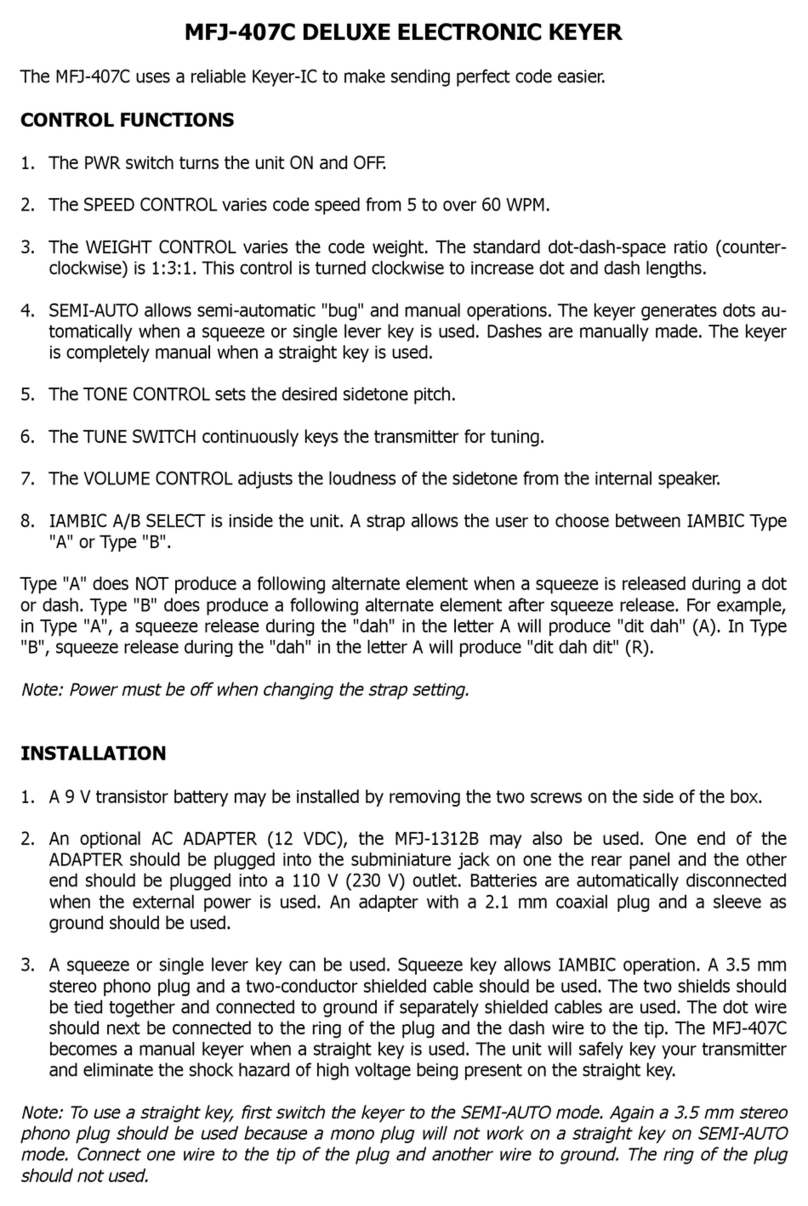
1-1
1. INTRODUCTION
The Hal Communications Model ST-6000 is a high performance FSK demodulator and tone key-
er designed for use with radio teleprinter systems. The ST-6000 incorporates the features and per-
formance characteristics of previous HAL demodulators as well as offering some features previous-
ly not available.
The ST-6000 is an audio tone type of demodulator and keyer. Audio tones from the receiver,
representing the "mark" and "space" teleprinter code states, are converted into keying pulses by
the demodulator section. Active input and discriminator filters are used in the ST-6000 so that a
wide range of input frequencies can be accommodated. Two standard audio tone sets are normally
stocked by the factory and special tone sets within the 1200 ... 3000 Hz frequency range are avail-
able on special order. The standard tone sets are based on a mark frequency of 1275 Hz ("low-
tone" set) or a mark frequency of 2125 Hz ("high-tone" set) for frequency shifts of 170 Hz, 425
Hz, and 850 Hz. The tone keyer section of the ST-6000 generates the same set of tones for trans-
mitting in addition to a narrow-shift tone for Morse code identification.
The demodulator uses a pre-filter AGC system, an active bandpass filter, a high gain, wide
bandwidth limiter, and active detector circuits. This combination gives outstanding performance for
a wide range of input signal amplitudes even in the face of strong interfering signals. The limiter
stage gain can be reduced for non-limiting operation ("AM"). The pre-filter AGC and active detec-
tors also assure improved non-limiting performance when compared to previous demodulators. A
three pole active lowpass filter follows the detector stages to reduce the post-detection noise
bandwidth.
An Automatic Threshold Correction (ATC) circuit can be switched into the signal chain to provide
correction for bias distortion generated by the propagation path. This feature can also be defeated
with a front panel switch if desired. A Decision Threshold Hysteresis (DTH) circuit can also be
switch selected to provide correction for multi-path propagation distortion of the teleprinter signal.
CMOS digital circuitry is used to provide the automatic printer and motor control as well as the
antispace feature. The ST-6000 autostart circuit senses the presence (or absence) of a valid tele-
printer signal. If the input signal is not recognized as a teleprinter signal, the printer is held in the
"mark-hold" condition. If more than twenty seconds pass without recognition of a valid signal, the
power to the printer motor is removed. The response time of the autostart circuit is switch selecta-
ble to allow "FAST" (1.5 sec.) or "SLOW" (3.5 sec.) response. An antispace circuit is also included
in the digital control section that limits the duration of a space signal to 250 ms or less, preventing
the "running-open" machine condition on continuous space tones.
As mentioned earlier, the tone keyer section generates the same tone set as is used in the de-
modulator section to assure true "transceive" conditions. The tone keyer will also generate an ad-
ditional narrow-shift tone that can be connected to an external keyer circuit for Morse code identi-
fication. All tones of the tone keyer are derived from high frequency crystal controlled oscillators.
The output signal is a low distortion sine-wave generated in a digital-to-analog converter and then
filtered in an active low-pass filter. A wide range of output amplitude (into 500 Ohms) it available
from the ST-6000, adjustable with an internal control. Unlike previous demodulators, the tone key-
er data input circuit is not internally connected to the demodulator but is available on a rear panel
connector. Thus, separate transmit and receive circuits (full-duplex) can be accommodated by the
ST-6000. Conversely, with appropriate rear-panel jumpers, the tone keyer can be connected to the
demodulator for a common transmit/receive circuit (half-duplex) as was the case for the ST-6 de-
modulator. However, the shift of the tone keyer is controlled by the front panel SHIFT switches. Al-
so, the SENSE switch (NORM - REV) controls both the tone keyer as well as the demodulator.


























